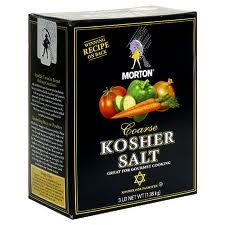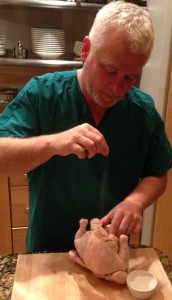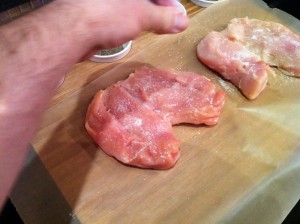Now that people are getting turkeys for Thanksgiving, people are discovering the joys, and mess of brining a turkey. Does brining prevent your turkey from being dry? Couldn’t you just salt a turkey instead?
One of the advantages of being a doctor is that we are pretty familiar with osmolar solutions, and how tissues react, as well as proteins in the body. Turns out we are kind of like turkeys – well, some of us more than others. Brining this year is the style. The technique is simple: dissolve salt in water, keep the turkey covered in the solution (refrigerated of course) for 1-3 days, rinse the turkey and let it dry uncovered for 24-48 hours. But wait, there’s more. Everyone has their favorite brine, where you add different herbs and spices to add flavor and substance to the brine. Ok- that sounds time-consuming and potentially messy, and really restricts your refrigerator space.
The common explanation of brining is osmosis. Which means salt and water move from a high concentration area (the brine) to an area of lower concentration (the tissues of the turkey). Turkey’s, like most life forms, are a bit salty – having evolved from the ocean, and while the ocean is still a bit more salty than we are,we could use sea water with minimal movement. So a solution that would not move salt into tissues would be normal saline , to make this would be 9 grams of salt in 1000 ml of water (or 1.62 level teaspoons in 4.2 cups). To compare, most brines are 6% solution (1/2 cup Kosher salt per quart) where the body is less than 1%.
When turkey is placed in a brine that contains more salt than normal saline (most brines), salt attempts to move into the tissues. If the brine is less salty (some cooks make this mistake) the tissues will swell with water (normalizing the salt concentration on both sides). Where this falls down is clear: if you soak a turkey in water, it will have more water in the turkey because of osmosis, no need to worry about salt. But putting a turkey in water, or a hypoosmolar solution, just doesn’t work. You do add water to the turkey, but it is cooked out quickly (its in what we doctors call the extra-vascular spaces).
But brining is more than adding salt to the tissues, or water to the tissues. Salt itself has an effect on proteins. Think of proteins as complex hairs, folded on themselves, and inside is the water. When you apply heat to the protein, it unravels, giving up the moisture – pushing it out. The maximum unfolding of proteins occurs at around 150 degrees F. If your turkey is cooked to over 150 degrees inside it will be dry. Below this temperature the proteins tend to retain their moisture. The theory of brining is that the salt works to denature proteins a bit to make them add more water. If you unravel proteins completely and apply heat, the protein will give up its water and the heat will move the moisture out of the turkey. If you denature the proteins in a cold solution, you unravel a bit, the theory goes, so that more moisture can be nestled into the protein sheath. Turns out the biochemistry sort of works.
Problems with brining:
Making room in your refrigerator for three days while the bird sits there in a solution is a pain. Some of this is made better by using a brine bag in an ice chest, where you can replace the ice throughout the three days. The ice chest keeps things cool enough to prevent most bacteria from growing, and it saves refrigerator space.
If you ever had a tasteless breast of chicken (most of them) or tasteless breast of turkey (most of them) they are tasteless because the meat flavor diminished as most are raised to have large breasts, with lots of water in them. Brining does the same thing. Chances are you will end up with much more plump meat, with less flavor.
Flavoring brines is the latest fad. So you not only have to know how much salt, but add sugar, rosemary, thyme, and maybe apple cider. Here is the problem when you add citrus to a brine- citrus unravels the proteins, and begins to change them (cook – think ceviche you cook the seafood with lemon or lime juice). Apple cider cooks the turkey while in the brine- and not in a very nice way. By pre-cooking you unravel the proteins to where they cannot return to a shape that will hold moisture – hence, the driest turkeys come from brines that have citrus (although they smell nice for a bit). Do not brine with apples or other citrus unless you like dry turkeys.
The other problem with using too many herbs is that if the herb sits up against one part of the meat for too long, that bit of meat will have way too much flavor of the herb – -you may like a bit of rosemary and sage, but you don’t want your meat to stay that way.
MYTH: Those herbs and spices do not make it into the meat -just on the surface, you can get the same reaction by following our recipe in our turkey tips section (click here). But lots of people will sell you those brines, and that’s ok, but the meat of the turkey will still be tasteless.
What about brining in chicken or turkey stock? It is a lot of work, without much reward.
Salting the turkey:
Salting the turkey has the same effect as brining, without the mess. If you salt the turkey you move moisture out of the cells, a concentrated brine. The salt moves in and does some denaturing of the proteins. The salt also helps dry the skin so that you have a far crispier skin than you would from a brine (if you never had turkey made with a crispy skin, then I am so sorry for you).
Salting a turkey prevents the increase in water of the turkey – and that means you will have more turkey flavor. Trust me, it is far more flavorful.
The other advantage is quite real – salting a bird has far less risk of bacterial contamination and cross contamination than a brine.
Salting Chicken:
I make a whole chicken at least once a week in my house. In the last year we have compared salting and brines, and salting wins out every time. The chicken, like turkey, is more flavorful when salted.
How to Salt the Bird
Salting is simple. Rain down kosher salt on a turkey. It should look like snow. I also separate the skin between the breast and the meat, as well as the skin on the thighs and salt those areas also (or rub it in). When I cook, I add some thyme or sage or rosemary, or sometimes ricotta cheese with those ingredients in it into the space between the muscle and the skin.
The key to having the turkey is keeping the temperature under 150 degrees. Remember, this is where the proteins will unfold and give up the water. The best way is sous vide method. I love this method because it gives me the best control of the temperature, and I cannot overcook the bird. I don’t have to take it out at the precise time and let the bird rest. I can leave the turkey in the Sous Vide water oven for longer than needed and take out the pieces and fry them.
Here is our Sous Vide video.
For those who prefer the traditional way to make a turkey – that will be our next article!
Coming Soon – our “Eating Book.” More than a cook-book, this book tells you how your body works with food. Included are simple recipes for everyone, but also are the in depth workings of your body and food- and a bit of history about it. The cook book for skeptics, the cook book for people who don’t cook. Stay tuned. Our working title of the book is:
JUST EAT
Recipes from a surgeon
Shattering myths about food from a weight loss doctor that knows your body inside and out










Very interesting article. Always like the scientific approach to cooking. The 150 degree temperature does concern me since salmonella doesn’t die until 165 degrees. Would love to see you address that concern.
First, that is simply not true. Salmonella dies at around 120 degrees, and cannot reproduce beyond 105 degrees F. Further, if you look at the definitions of cell kill, you can see that this allows the death of 99.9995% of the bugs.